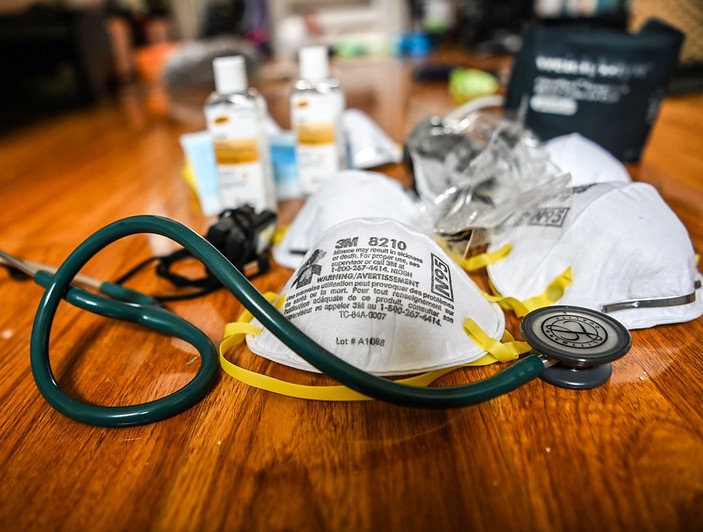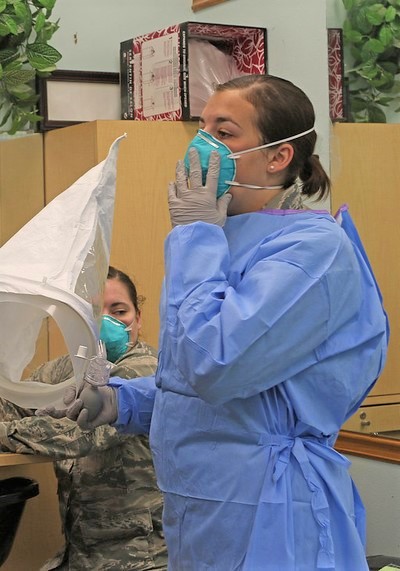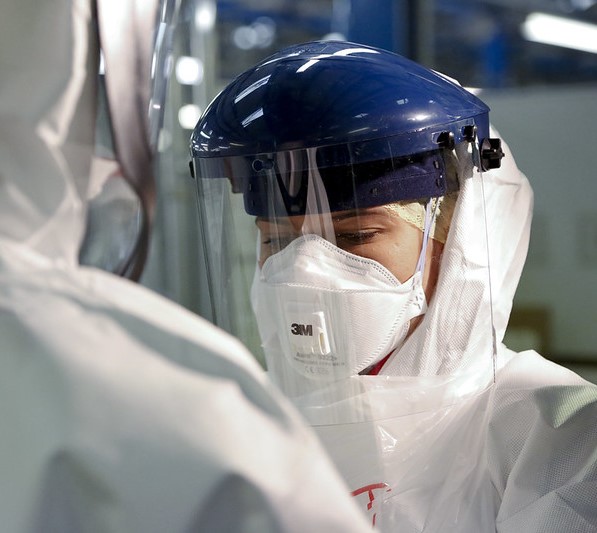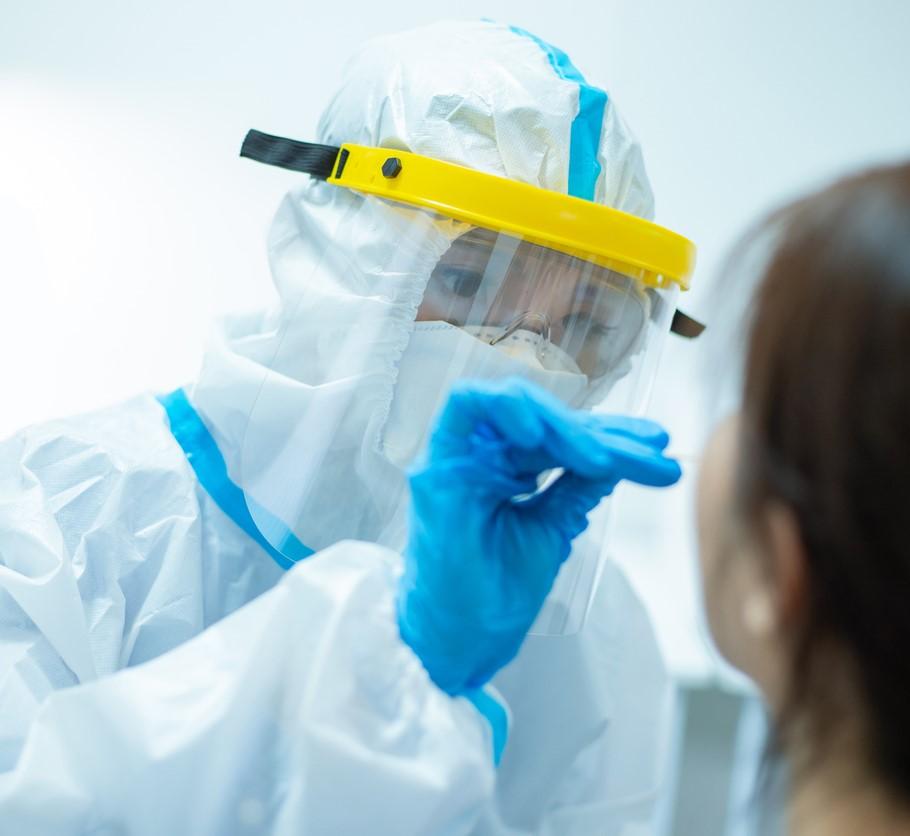One of the more unsettling images from the early days of the coronavirus pandemic in the United States came from New York in late March. In a photo that quickly went viral on social media, nurses from Manhattan's Mount Sinai Hospital were seen wearing surgical masks, face shields, gloves, and trash bags over their scrubs.
"NO MORE GOWNS IN THE WHOLE HOSPITAL" read the caption in the image, which was later deleted.
That photo encapsulated the problems that many hospitals in New York and other hard-hit parts of the country were experiencing as they dealt with a crush of COVID-19 patients. On top of being overwhelmed with severely ill people, healthcare workers were dealing with shortages of the personal protective equipment (PPE) that they need to keep from getting infected themselves. N95 respirators, surgical masks, gowns, and gloves were all were in short supply, forcing hospitals to ration them.
At the root of the issue were several problems: a global surge in demand for protective gear that was outstripping supply, a lack of adequate supplies in the Strategic National Stockpile, which is intended to supplement state and local supplies during public health emergencies, and a response that lacked any federal coordination. A nationwide scrum for available PPE ensued, pitting state governments, healthcare systems, and individual hospitals against each other as they fought to outbid each other for adequate supplies for the pandemic response.
 Four months later, many hospitals have a better supply of PPE than they did in March and April. But with the dramatic nationwide rise in coronavirus cases that began in mid-June and shows no signs of slowing, concerns about PPE supplies remain. And demand is now coming not only from the hospitals that are treating COVID-19 patients, but also from nursing homes, primary care doctors who want to ensure a safe environment as they begin welcoming back patients for routine primary care, and other frontline healthcare workers.
Four months later, many hospitals have a better supply of PPE than they did in March and April. But with the dramatic nationwide rise in coronavirus cases that began in mid-June and shows no signs of slowing, concerns about PPE supplies remain. And demand is now coming not only from the hospitals that are treating COVID-19 patients, but also from nursing homes, primary care doctors who want to ensure a safe environment as they begin welcoming back patients for routine primary care, and other frontline healthcare workers.
And some say the problem truly never went away. Some hospitals are doing better than others, but even in the hospitals that have an adequate supply of PPE, many healthcare workers still have to reuse equipment that, under normal circumstances, is intended to be used only once.
PPE requests are rising
GetUsPPE, a nonprofit organization led by medical professionals that formed in March to get protective equipment to healthcare workers and other first responders and has delivered more than 2.1 million units since it started, currently has more than 13,000 active requests for PPE in its database, and has filled only 10% of those requests.
Data the group shared with CIDRAP News show that after dipping in May and early June, requests from Arizona, Texas, and Florida started to spike again in the middle of June. Among the items that have seen a steady rise in demand are surgical gowns and coveralls.
"The situation is slightly better than what we saw in the beginning of the pandemic, but we're going from terrible to just bad," said Matt Wellington of U.S. PIRG (Public Interest Research Groups), which has been working with GetUsPPE and others to address the PPE shortage. "We're still seeing shortages across the country, health professionals are still raising the alarm that they don't have adequate supplies of PPE to protect themselves while they care for patients, and the spikes that we're seeing in COVID-19 cases and rising hospitalizations is putting a lot of stress on an already very fragile supply chain."
While demand for PPE from hospitals continues, GetUsPPE organizers say they're seeing increasing requests coming from other types of care facilities, like nursing homes, which have been hit hard by COVID-19.
In a recent letter sent to the National Governor's Association, the American Health Care Association and the National Center for Assisted Living urged state public health agencies to provide additional support on PPEs, particularly N95 respirators, which provide better respiratory protection than masks do. The groups said that nearly 20% of nursing homes reporting to the Centers for Disease Control and Prevention (CDC) had less than a 1-week supply of PPE, and more than half of assisted living communities have less than a 2-week supply of N95s and gowns.
"N95 masks are still not available and were not included in the FEMA shipments to nursing homes," the groups wrote, referring to the Federal Emergency Management Agency.
In a Jun 30 letter to Vice President Mike Pence, American Medical Association (AMA) President James Madara, MD, urged the Trump administration to use the Defense Production Act to make sure there is sufficient PPE for physicians in all settings.
"As the AMA continues to communicate with physicians during the pandemic, they tell us the biggest challenge to reopening their practices is the ongoing shortages of PPE, especially N95 masks and gowns," Madara said, explaining that physicians in ambulatory settings don't have the ability to source these items. "Without adequate PPE, physician practices may have to continue deferring care or remain closed, which will continue to have a dramatic impact on the health of their patients."
Forced to adapt
Among those affected is Matthew Stine, DO, a family care practitioner with an independent practice in Aledo, Texas, a state that's currently one of the nation's hot spots. In an email to CIDRAP News, Stine said his practice, which serves 500 to 600 patients a month, has received 10 medical gowns and no N95 respirators from the medical supply distributor he's used for more than 10 years.
Forced to adapt, Stine says he bought 10 P95 painting respirators from a local paint store in March, along with hooded and sleeved plastic ponchos he found on Amazon. "They have worked reasonably well even though they are difficult to wear outside in the Texas summer," he said.
Stine did receive 60 N95s after appealing to local and state authorities, but he has to reuse them, as the spike in cases in Texas has made him less comfortable with wearing surgical masks in the office.
"I am using an N95 for 2 days and then placing it in a paper bag for a minimum of 2 weeks before reusing the mask," he said.
First responders also continue to work without the equipment they feel they need. An emergency medical technician (EMT) with the New York City Fire Department, who asked to remain anonymous, told CIDRAP News in an email that under a rule that went into effect on Mar 22, EMTs were advised to wear surgical masks during encounters with suspected COVID-19 patients instead of N95 respirators, unless the patient is in cardiac arrest or is receiving an aerosol-generating procedure.
That order, issued after the CDC revised its guidelines on PPE use on Mar 10 because of the shortages, is less enforced than it was in March and April, when the PPE shortage was dire, the EMT said. But the department is still rationing N95s, he said, and he and his partner have had to buy respirators with their own money.
"I would not want to treat any symptomatic COVID-19 patient without an N95," he said. "The patient compartment of an ambulance is compact, and even though in theory there is a vent to circulate air, [you are] definitely breathing shared air for 10-15 minutes."
"[I] definitely don't feel safe using a surgical masks on COVID calls," he added.
Surgical masks and N95s are both intended to minimize the spread of SARS-CoV-2, the virus that causes COVID-19, but surgical masks do not protect users from small airborne aerosols. N95s, so-called because they filter out 95% of airborne particles, can limit the spread of aerosolized virus, as well as protect against virus-laden droplets. The CDC's revised guidelines recommend that the use of N95 respirators, under crisis capacity situations, be prioritized by activity, and allow for N95s to be re-used on a limited basis.
In a survey posted yesterday by National Nurses United, the largest nurses' union in the country, 87% of nurses who work in hospitals reported reusing at least one piece of PPE, and 54% said their employer has implemented a program to clean single-use PPE, such as N95 respirators, between uses. Some frontline healthcare workers aren't happy about that.
"There has never been enough PPE," said Rick Fuentes of the Minnesota Nurses Association. "PPE is still being rationed and not being used properly or even as the manufacturers intended."
Fuentes said that PPE supply varies from hospital to hospital in Minnesota, and that "there's a huge difference between what's available on the floor, available in hospital storerooms, and available in state warehouses."
Demand is overtaking supply
As the PPE shortage in March and April started to dominate the headlines, the lack of adequate backup in the National Emergency Stockpile and the federal government's inability to provide states with what they needed came under scrutiny. To speed up the shipment of PPE, the Trump administration created Project Airbridge, a partnership between FEMA and six major medical equipment distributors to bring PPE from overseas and get it to frontline workers.
 That has helped alleviate the shortages. In an email, a FEMA spokesperson noted that, as of Jul 14, FEMA and the Department of Health and Human Services have coordinated delivery of 103.1 million N95 masks, 159.3 million surgical masks, 17.2 million face shields, 74.5 million surgical gowns/coveralls, 139.4 million gloves, 34.2 million K95 respirators, 13.8 million KN90 masks, and 2.4 million thermometers. But the spokesperson said much of the supply is now being stockpiled.
That has helped alleviate the shortages. In an email, a FEMA spokesperson noted that, as of Jul 14, FEMA and the Department of Health and Human Services have coordinated delivery of 103.1 million N95 masks, 159.3 million surgical masks, 17.2 million face shields, 74.5 million surgical gowns/coveralls, 139.4 million gloves, 34.2 million K95 respirators, 13.8 million KN90 masks, and 2.4 million thermometers. But the spokesperson said much of the supply is now being stockpiled.
"Demand is overtaking supply because hospitals, states, and the federal government is stockpiling PPE," the FEMA spokesperson said.
In a recent memo from the House Committee on Oversight Reform that summarizes discussions between staff members and representatives of the six medical distribution companies playing a role in the Trump administration's response to the coronavirus, an official from Concordance Healthcare Solution said he or she didn't see demand wavering any time soon. "Supply is still coming in, but not enough to meet demand," the official said.
And in a document containing US PPE demand and supply projections that was provided to the Senate Homeland Security and Governmental Affairs Committee in early June, the anticipated demand for N95 masks from July through October continues to outstrip supply from domestic manufacturers and imports.
The document from the White House COVID-19 supply chain task force suggests the anticipated shortfall of roughly 30 million N95 respirators could be met by reusing N95s decontaminated with the Battelle Critical Care Decontamination System, which uses concentrated vapor phase hydrogen peroxide to deactivate organisms. The Food and Drug Administration issued an Emergency Use Authorization for the system in June, but some healthcare worker unions have questioned the safety of the system, and others say it remains understudied.
The document also indicates that the anticipated shortfall in surgical gowns could be met largely by reusing gowns.
"The White House's own internal data, just released a few weeks ago, shows we're still facing shortages of tens of millions of N95 masks and gowns, and those shortages may persist for months," Representative James Clyburn (D-South Carolina), said in a Jul 2 hearing of the House Oversight and Reform Subcommittee on the Coronavirus Crisis, in reference to that document. And that document was from early June, prior to the surge in cases that the country has seen in recent weeks, Clyburn noted.
"I'm cognizant of the increases, but states are reporting, and hospitals are reporting, more supplies on hand," Rear Admiral John Polowczyk, supply chain stabilization task force leader, replied. Polowczyk said that states have been stockpiling PPE, and that 70% of states had at least 30 to 90 days of supplies on hand. He also noted that the federal government is only one source of PPE. States and hospital systems are still procuring PPE on their own, and some has been donated.
But with COVID-19 cases spiking and hospitals filling up, primary care providers like Stine, who says his requests to officials in Texas for more medical gowns have gone unanswered, are left empty-handed.
"Despite 2 months of requests, we still have not received any gowns from state authorities," he says.
Calls for more coordination
Wellington says that a major part of the problem is that coordination "is still an absolute mess," and states are still competing against each other for supplies, pushing up prices and preventing healthcare providers from getting equipment.
To fix the problem, USPIRG is supporting legislation that would boost domestic PPE production and establish a central coordinator position within the government that would oversee federal purchasing and distribution of medical supplies and have the authority to use the defense production act to produce more equipment. Wellington says the bill, known as the Medical Supply Transparency and Delivery Act, would "plug the glaring holes" that exist in the medical supply chain.
 The proposed legislation would also create a system in which PPE supplies, incoming requests, and fulfillment of those requests, would all be visible.
The proposed legislation would also create a system in which PPE supplies, incoming requests, and fulfillment of those requests, would all be visible.
"That kind of visibility doesn't exist right now, and that's why we're seeing so much confusion among states and local governments about how to get these materials," Wellington said.
Wellington says the federal government has to step up to keep healthcare workers safe. To date, 878 US healthcare workers have died after caring for patients with COVID-19, according to reporting today by Kaiser Health News and The Guardian.
"We need to be able to protect healthcare workers so that they can stay safe while they save people's lives," he said.






















